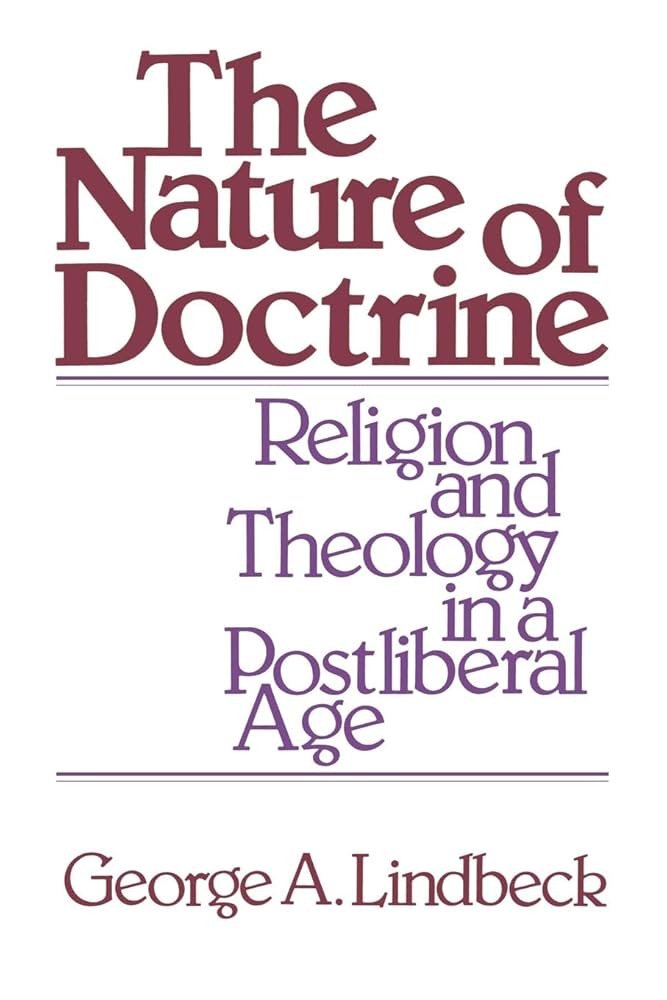Clinging to the Cross
'The Nature of Doctrine' and the Cross Out of Context
“And like many a Christian before them, they completely forgot that the only sword-shaped weapon Jesus ever actually used was the one He died on.”
David James Duncan, The Brothers K
Often, right after I publish a piece of writing in which I’ve meandered my way to making a point, I come across a book that puts what I’ve been trying to say so clearly that my immediate impulse is to delete the post and start over.
I wouldn’t actually do that (maybe). But when it happened after my series in which I traced some history of the cross taken out of context, I had to write just a few more thoughts on the subject.
What book brought about this writing crisis, you might ask?
George Lindbeck’s foundational text: The Nature of Doctrine.
The Nature of Doctrine
For the uninitiated (like me), Lindbeck and a handful of other theologians at Yale Divinity School in the mid-1980s began to explain a way of thinking about theology that was meant to help grapple with a couple of doctrinal issues they were facing.
First was the problem of doctrinal dialogue between different Christian traditions. (He was a Lutheran who interacted with a lot of Catholics in and around Vatican II). He was very curious about how a bunch of theologians from various traditions were able to bring completely different ways of describing things about the Christian faith, and then all confirm they were basically in agreement.
Second, he was trying to make sense of two different theological streams that were at odds with each other:
1. The Fundamentalists who were committed to doctrine limited to very specific words in which no other words could ever be used to describe correct doctrine. (He would call this the Cognitive-Propositional paradigm)
2. The Liberals (not political liberals, we’re talking theology here) who were committed to the words of doctrine as symbolic of whatever was being experienced in their lives and the culture around them. (These Lindbeck would describe as the proponents of the Experiential-Expressivist paradigm.)
This second problem would make up most of what is directly addressed in the book. The first problem would function as a clue for explaining another possible way that doctrine works.
It is this third way of how doctrine is understood that I wish I’d have had in my tool belt when trying to unpack the significance of the cross taken out of context.
Lindbeck argues, I think, convincingly for a way of understanding doctrine in terms of its “cultural-linguistic” character. Religion, Lindbeck says, is like being a part of a whole new culture with its own practices, beliefs, and norms in the midst of the broader culture.
Doctrine and religion, he says, are not simply a set of propositions to which we give intellectual assent (cognitive-propositional). It is also not informed first by our experience (experiential-expressivist).
Rather, to put his concepts very simply, it is a bit of both, and neither of both. (I didn’t say easily understood, just put simply).
A Cultural-Linguistic way of understanding doctrine is akin to a set of grammatical rules in a language. This “grammar” is something one intuitively learns to grasp by taking on the practices and norms of the faith community, which are anchored to a particular story.
In the case of Christianity, it is the story of Israel that culminates in Jesus’ incarnation, life, death, resurrection, ascension, and return.
In some ways, it is very much like a cross-cultural experience where a person is immersed in a totally new way of life that often conflicts with their own experience and often doesn’t seem to make sense on the surface. Yet underneath, there is a clear logic for those who have been trained in the culture of the tradition.
It is when one is deeply embedded in this new way of life that all of the rites, prayers, and symbols of this new “culture” are grasped in their full meaning. Specific words and language are used to describe this meaning, but the words only ever point to the reality that is just beyond words.
To put it another way, it is somewhat “caught” rather than “taught,” while still based on unchanging truths.
This is why, according to Lindbeck, Lutherans, Catholics, Methodists, and Episcopalians could have very different doctrinal language and still all agree they were saying the same thing and were unified.
There is a lot more to this, but that is at least a very basic way of describing what he’s doing in the book.
What Does This Have To Do With The Cross?
Truth, in a Cultural-Linguistic doctrinal framework, functions more narratively than as propositional statements that we agree with (remember words and statements can’t fully grasp the truth of the faith being practiced).
Rather, in a story, a narrative, one can read between the lines, experience the nuance and meaning in the various relationships of characters in the story. Deeper meanings can be grasped that transcend the words telling the story itself. We are moved emotionally by the story. All of this comes together to give us a narrative description that informs the way we practice the faith.
By the way, it should be noted here that “story” does not mean “made up.” It is a story that informs the way we live our lives. We all tell ourselves stories that inform our behavior. Some stories are helpful, others not.
I used to tell myself the story that I had to change who I was in different settings so I could be welcomed by the group I was with. I’ve also told myself for a long time that I wasn’t a good reader and wasn’t particularly good at school. It led to a behavior that disengaged from trying to read books for a long time.
In Christianity, we tell the story of a God who created a good world in which humans were given the opportunity to make choices, and those choices resulted in a fractured and broken world. God, however, still loves this world and revealed Godself to a family that became a people so that they could bless all the people of the earth.
The ultimate climax of this story is when God entered into this world, became human like us, and revealed what God is fully like in Jesus. The humility and gentleness of God revealed in Jesus was given its ultimate meaning in the death and resurrection of Jesus and his return to heaven to sit at the right hand of God the Father.
This story, and all the layers of nuance which we read in the Christian scriptures and which come through in our prayers of confession and forgiveness, our practices of serving the least of these, and many more, reveal a God in Jesus who never violently resisted or led a military revolt but succumbed to the military and political powers of the day, laying down his life.
The cross was a repulsive sign of pathetic weakness on which only subhumans and enemies of the Roman State were executed. Roman citizens themselves would never be treated in such a way, and even the Roman elite would never wish crucifixion on their worst enemy (beheading was just fine though 🙃).
That means God in Jesus suffered the most stigmatizing kind of punishment known to both Greek and Jewish society. He was truly a man of sorrows and of weakness.
The Christian story, we believe, leads us to a set of behaviors in which we are called to model this same weakness and sorrow. Famously, the apostle Paul wrote we are to imitate Christ’s very nature, who…
“Being God did not consider equality with God something to be grasped but made himself nothing…” (Philippians 2:6-7a)
This level of weakness and humility, while displayed in some corners of Christianity, is not often displayed by many of the so-called American Evangelicals vying for political power and attempting to dominate society through worldly means.
Here is where Lindbeck’s insights are massively helpful (and why I’m still slightly annoyed I hadn’t read this book before writing that series on the cross…pray for me).
In the “Cognitive-Propositional” model of doctrine, all that matters is saying and knowing the correct words. Saying “Jesus is Lord” is true and enough.
But is the statement “Jesus is Lord” the same when the suffering apostle Paul says it as when a crusader shouts it while he raises his sword to cut down his enemy? (That’s Lindbeck’s example).
In other words, is there something deeper than the words that matter here?
Lindbeck would say yes. The words are our best language in a particular culture to describe and point to the real thing about God that is beyond what our words can describe.
And connected to that language is a way of life, practices, and behaviors all embedded in a community that is living in the flow of the story of Jesus. The words may change at different times in history, but the core way of being, the deep “grammar” as Lindbeck calls it, doesn’t change.
When it comes to the cross, the full narrative, the full story of Jesus, including how Jesus relates his own life to the cross, needs to be utilized in our practice of being Christian to “maximum” effect. We need to be living in the fullness of all that it means that Jesus “became nothing” in order for the statement “Jesus is Lord” to mean what it means.
At the risk of dropping a long quote that might lose some people, Lindbeck writes it this way,
“If the interpretive scheme is used or the story is told without this interest in the maximally important, it ceases to function religiously. To be sure, it may continue to shape in various ways the attitudes, sentiments, and conduct of individuals and of groups. A religion, in other words, may continue to exercise immense influence on the way people experience themselves and their world even when it is no longer explicitly adhered to.”1 (my emphasis added)
To put it another way, American Evangelicalism has left behind part of the “maximally important” part of Christianity, which is to be like Jesus: humble, becoming nothing, servant of all, not taking up the means of power used by the world, but rather, clinging to the cross. We have fallen into exactly what Lindbeck described all the way back in 1984: religious language is still holding immense influence while no longer explicitly adhered to.
This is how you can get the cross lifted high with banners saying “Jesus is Lord” while at the same time attacking the US Capitol and shouting for the Capitol police to be killed.
When the cross gets removed from the deep grammar of what Christianity really means, almost anything can happen.
On the one hand, we have this extreme version of fundamentalism, but lest some of us get too judgey, there are other things that can happen when the story of Jesus isn’t taken in the maximally important way.
In a secular society such as ours, one can pick and choose from a variety of experiences that feel good to them. It becomes like a religious buffet. Eastern meditation, for example, is on the rise in the West. But it isn’t anchored in the culture and lifestyle that accompanied those practices for centuries; it is Westernized; borrowed for our convenience because we no longer have a shared religious practice, and so many are desperate to feel grounded.
I’m not saying that because we are Westerners, we must be Christian. (Though I believe following Jesus is the best way to live). I am saying Western civilization has been formed and shaped by Christianity in all its logic and rationale, yet now we stumble around with vague commitments disconnected from their concrete purposes.
For example, we call for human rights, but do not understand that our ability to do so in the West is fundamentally rooted in the Christian and Jewish belief that every human is created in the image of God. We become unmoored from the coherent foundation that allows us to call for human rights.
When this happens, we make ourselves the center, we become our own Jesus, or God, or Ultimate Reality. We become our own arbiter of truth and fulfillment, whether we know it or not. The downside to this is that every experience on its own eventually succumbs to real life.
When this happens, we question ourselves and our own existence. We have a midlife crisis (again and again) because our experiences don’t have the resources to lead us through troubled times. This is some of what the Experiential-Expressivist framework that Lindbeck describes does to our culture.
In this paradigm, too, the cross becomes emptied to mean, “I can feel good about myself because Jesus died on it for me.” It is therapeutic and not something that I too must take up and follow Jesus with. It does not make demands on me that are too uncomfortable or extreme.
Both directions (a personal spiritual buffet, or using ‘Jesus is Lord’ to exert worldly power over others), while they might look very different, are essentially anchored in the same problem: Leaving behind an understanding of the Christian faith as an alternative culture that shapes our way of being in its totality.
This Cultural-Linguistic option is rather un-sexy. It grounds us in a community. It commits us to a shared way of being in the world with others that feels very limiting, especially for us in the Western world, who like our autonomous, radical individualistic selves. It also doesn’t try to grab power because it is informed by the fullness of the story of Jesus and our call to cling to the cross as He did.
Quite often, trying to follow Jesus in a community like this means there’s no exciting thing happening that we can get hyped about. There is no new ground to “Take back” from the enemy (which usually is just code to mean the culture around us, not actually the devil), and there are overall just too many limitations on how to live one’s life.
This version of Christianity is just too limiting.
Yet, this is the only version of Christian life that seems to have a solution to our loneliness epidemic.
It seems to be the only version of the Christian life that has a sense of meaning robust enough to last through volatile cultural change happening at increasingly rapid rates.
It is likely the only version of Christianity that leads me in love towards all people, while remaining firmly grounded in the way of Jesus without compromise.
Hype, Experience, and taking the next hill are far too overrated, and I’m meeting more and more people who are just struggling to feel grounded and have a sense of “place.”
If the Church wants to recapture what makes her so compelling, we need to become these deeply rooted kinds of communities that share a way of life together, anchored in the story of Jesus. We need to carve out a grounded way of life that creates “place” for those longing to belong.
We aren’t reinventing the wheel here. Jesus has already made the way; we just have to cling to the cross we were meant to carry and quietly follow Him.
Thanks for reading. If this was helpful, please let me know by leaving a like, comment, or sharing with a friend who would find this helpful too!
Lindbeck, The Nature of Doctrine, 33.






